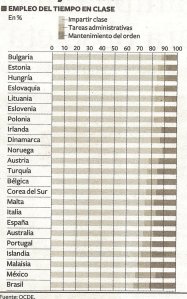 Ozbek, the publisher’s rep, got on to the subject of ‘flow’. He was driving me from the airport into the centre of Istanbul, and it turned out that he was currently researching a Masters dissertation on motivation. He was attracted by the idea that intrinsic motivation is located in the present moment, and reaches a peak when you are so absorbed in a task that time seems to slow down or even to stop altogther (akin to what the art critic Michael Fried calls ‘presentness’, as in “Presentness is grace”). This is also what the psychologist Mihaly Csikszentmihalyi calls “flow”. It is the kind of ‘peak experience’ often reported by artists or sportspeople, when there is a perfect match between performance challenge and available skill. Here’s how a world-class figure skater describes a typical flow experience (from Csikszentmihalyi 1993):
Ozbek, the publisher’s rep, got on to the subject of ‘flow’. He was driving me from the airport into the centre of Istanbul, and it turned out that he was currently researching a Masters dissertation on motivation. He was attracted by the idea that intrinsic motivation is located in the present moment, and reaches a peak when you are so absorbed in a task that time seems to slow down or even to stop altogther (akin to what the art critic Michael Fried calls ‘presentness’, as in “Presentness is grace”). This is also what the psychologist Mihaly Csikszentmihalyi calls “flow”. It is the kind of ‘peak experience’ often reported by artists or sportspeople, when there is a perfect match between performance challenge and available skill. Here’s how a world-class figure skater describes a typical flow experience (from Csikszentmihalyi 1993):
I knew every single moment; in fact I even remember going down into a jump and this is awful, but thinking, “Oh gosh, this is so real! I’m so clear in my thoughts.” There was just a real clarity to it all… I felt such control of everything, every little movement, I was very aware, you know, like what was on my hand, I could feel my rings, I could feel everything, and I felt I had control of anything (p. 182).
According to Csikszentmihalyi, flow experiences have the following characteristics:
1. they have concrete goals and manageable rules.
2. they make it possible to adjust opportunities for action to our capacities
3. they provide clear information about how well we are doing
3. they screen out distractions and make concentration possible
(Csikszentmihalyi 1993: xiv)
I had read about flow in the 1990s, and had been attracted by the notion that a task can be intrinsically motivating when one’s available skills are perfectly calibrated with the task’s degree of challenge. The alternatives, such as too much challenge, or too little, are likely to result in either anxiety or boredom.
Appearing as it did around the same time as the popularization of task-based learning, the theory seemed to offer an elegant rubric for the design and management of second-language learning tasks. The theory suggested that good tasks should stretch learners, pushing them beyond their immediate ‘comfort zone’, while at the same time providing them with sufficient support so as not to induce anxiety. But since then Csikszentmihalyi’s theory seems to have lost traction, so I was intrigued to hear my Turkish friend (in gridlocked traffic that was the antithesis of flow!) update me on a couple of recent studies (copies of which he subsequently sent me) that have rehabilitated the notion of flow.
One of these – (Egbert 2003) – reports a study in which students rated their experience of various classroom tasks (such as reading aloud, group discussion, etc). The one task that seemed to have induced the greatest degree of flow, based on self-report data, was one in which the students (all US high-school students of Spanish) interacted freely in a chatroom discussion with Spanish-speaking contemporaries. The researchers concluded that tasks which are most conducive to flow are those in which the participants’ perceptions of challenge, control, and interest are optimal.
This leads me to wonder if the concept of flow applies, not only to learning, but also to teaching. That is to say, do teachers experience flow? Of course, “flow” – in a slightly different sense – is a concept that has often been invoked by educators to capture a desirable quality of classroom management. For example, in a study of the metaphors that one teacher employed when describing her teaching, Munby (1986) noted the constant use of the metaphor of the “lesson as moving object”. E.g. “I keep it rolling all the time”, “I seem to move along real well with that class” etc. Flow, in this sense, is a function of having well rehearsed classroom routines, and it typically distinguishes the teaching of experienced teachers from the rather stop-start nature of novice teaching.
But, flow – in the optimal experience sense – is surely something more than just being a good manager. If so, what characterizes it, what kinds of teachers experience it, and what are its preconditions? And what might all this suggest for teacher education and development?
Refs:
Csikszentmihalyi, M. 1990. Flow: The Psychology of Optimal Experience. NY: Harper Row.
– 1993. The Evolving Self: A Psychology for the Third Millennium. NY: Harper Row.
Egbert, J. 2003. ‘A study of Flow Theory in the foreign language classroom’. The Modern Language Journal, 87/4.
Munby, H. 1986. ‘Metaphor in the thinking of teachers: An exploratory study’. Journal of Curriculum Studies, 18/2.
van Lier, L. 1996. Interaction in the Language Curriculum: Awareness, Autonomy & Authenticity. Harlow: Longman.









Recent comments